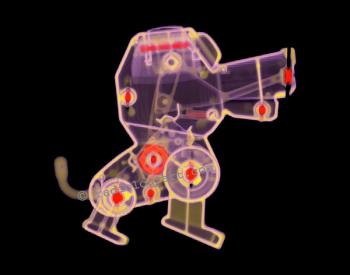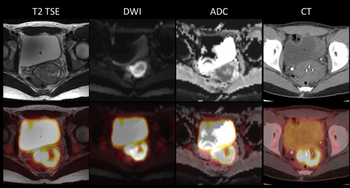
Could PET/MR be a better modality than conventional MR and CT for bladder cancer?

Could PET/MR be a better modality than conventional MR and CT for bladder cancer?

VIDEO: Mark Flyer, MD, CIIP, of Maimonides Medical Center, shares the experiences and lessons learned when his facility implemented a critical test results management system.

VIDEO: ACR president Albert Blumberg, MD, discusses CMS’s reimbursement cuts and the shared challenges of radiologists and radiation oncologists.

Hackensack University Medical Center has earned ACR’s distinction as one of the first two Diagnostic Imaging Centers of Excellence. Here’s how they did it.

VIDEO: Cincinnati Children’s is creating a department-specific blog to connect with and educate patients. Matt Hawkins, MD, discusses the blog’s prep and planning.

VIDEO: Bradley Erickson, MD, PhD, FSIIM, explains translational research and the challenges facing innovative radiology organizations.

The best way to maximize clinical adoption of a new enterprise viewer would be to get physicians involved in the selection process, IT officials said at SIIM 2013.

The use of mobile technologies in healthcare continues to grow, with staff accessing data on their own devices.

Waiting to jump head-first into the federal government’s meaningful use program? That might not be a bad idea, David Avrin, MD, said at SIIM.

Clinical decision support can assist multiple times in the medical imaging chain to improve efficiency and patient care, according to experts at SIIM 2013.

Very few HIEs transfer medical images, but that data together with an exchange approach that aggregates patient data will reveal HIE’s potential, say experts at SIIM 2013.

VIDEO: Reimbursement for CT colonography has been a complicated path, but radiologists shouldn’t wait to pursue local coverage and set up a screening program, said Perry Pickhardt, MD.

Radiologist and artist Satre Stuelke, MD, MFA, acquires CT scans of toys, food, and electronics.

Keith Dreyer, DO, PhD, FACR, FSIIM, a well-known expert on meaningful use in radiology, offers his take on the findings of this recent survey.

VIDEO: Peter Moskowitz, MD, of the Center for Professional and Personal Renewal, offers radiologists suggestions for finding balance and avoiding burnout.

VIDEO: Ordering habits for imaging exams don’t change when cost is displayed. Daniel Brotman, MD, discusses why imaging seems to be a “different animal.”

To avoid patient identification errors with biopsy results, some radiology practices are using a system to track and match samples for added security.

Early breast tomosynthesis adopter Washington Radiology Associates increased cancer detection by one-third, decreased call-backs, and improved provider confidence.

Stacy Johnson, of Presbyterian Intercommunity Hospital, discusses the use of technology to meet California’s dose reporting requirement and the law’s impact.

CHICAGO - If your radiology practice doesn’t have conflict of interest policies in place, you’re not alone. Here’s why it’s important and what to do.

CHICAGO - Point-of-care ultrasound has become ubiquitous in medicine, but radiologists still have a critical role in the modality with ultrasound’s training and promotion.

CHICAGO - Richard Gunderman, MD, urges radiologists to see beyond the superficial scans and tell the stories behind the images.

CHICAGO - CT colonography’s path to reimbursement has been a complicated process, standing as a reminder for radiologists to get involved in political advocacy.

Speech recognition software can be leveraged to tell if a radiologist is stressed, prompting individualized interventions to improve quality and satisfaction.

Medical imaging use and costs have declined in recent years. But has this downward trend affected quality and patient safety?

Most radiologists are eligible for the meaningful use program, says Keith J. Dreyer, DO, PhD. So don’t be tempted by the hardship exemption.

Medical imaging manufacturers are calling on Congress to protect the national helium reserve to avoid negatively impacting MRI production and patient access.

A new Image Gently initiative emphasizes proper pediatric imaging procedures as technology shifts from standard screen-film X-ray to digital X-ray.

Raymond Tu, MD, discusses the considerations for implementing a new lower dose mammography system, including patient safety, market share, and cost.

Washington University’s Mallinckrodt Institute of Radiology is imaging cervical cancer patients with hybrid PET/MR. Here’s what they’ve learned about this new modality.

Published: July 29th 2013 | Updated:

Published: July 15th 2013 | Updated:

Published: March 24th 2014 | Updated:

Published: January 5th 2011 | Updated:

Published: January 14th 2011 | Updated:

Published: January 19th 2011 | Updated: